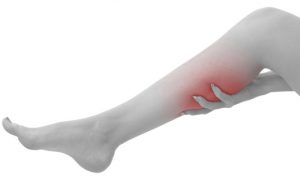
Leg cramps at night, different from restless leg syndrome
Both nocturnal leg cramps and restless leg syndrome (RLS) occur during sleeping hours but that is the only similarity between the two conditions. There are many differences between leg cramps at night and restless leg syndrome, including:
- RLS does not cause pain or cramping, while nocturnal leg cramps do.
- RLS is more of a discomfort or crawling feeling in your legs.
- RLS causes the desire to move the legs, while nocturnal leg cramps often prevent movement.
- Moving the leg in RLS offers relief – moving the leg in nocturnal leg cramps does not, instead stretching is required.
Causes and risk factors of leg cramps at night
The exact cause of nocturnal leg cramps is often unknown, but potential causes and risk factors include:
- Sitting for prolonged periods of time
- Over-exertion of the muscles in the leg
- Standing or working on concrete floors
- Sitting improperly
Medical conditions, too, can contribute to nocturnal leg cramps, such as:
- Pregnancy
- Alcoholism
- Dehydration
- Parkinson’s disease
- Neuromuscular disorders
- Structural disorders like flat feet
- Endocrine disorders like diabetes
- Diuretics, statins, beta agonists
Treatment and prevention for nocturnal leg cramps
Treatment depends on the cause. For example, if the cause of your nocturnal leg cramps is due to dehydration, ensure you stay well hydrated throughout the day. Other treatment and preventative methods for leg cramps at night include:
- Take a relaxing, warm bath prior to sleep to ease any muscle tightness.
- Apply a heating pad to the affected area.
- Try acupuncture treatment to loosen tight leg muscles.
- Ensure you are not deficient in magnesium or potassium – deficiencies in both minerals are linked to muscle cramping.
- Stretch your legs prior to bed.
- Partake in water exercises to build leg muscles.
- Wear ergonomic shoes and avoid high heels.
What to do when cramps occur
When a nocturnal muscle cramp strikes it can nearly leave you paralyzed. Knowing how to properly handle an attack will offer you relief and leave you less sore afterwards. Here are some tips to better handle nocturnal leg cramps.
- While sitting on the floor extend both legs out in front of you. Now flex your feet at the ankles and point your toes toward your knees – you may want to tug on your feet to offer an even better stretch.
- Get up slowly and walk around a bit – shaking your legs can also improve blood flow.
- Gently massage the area in a circular motion.
- Ensure blankets and sheets are not tight enough to make the leg muscle contract.
- Take a tablespoon of yellow mustard to relieve discomfort.
Related Reading:
Restless leg syndrome (RLS) is symptom for stroke, heart and kidney disease: Study
Restless leg syndrome has been found to increase the risk of stroke, heart disease and kidney disease. Restless leg syndrome (RLS) is a condition that causes a person to feel an overwhelming urge to move their legs when in an inclined position (laying down). Tingling, aching and itching sensations may occur as well. Continue reading…
Early multiple sclerosis symptoms: Restless leg syndrome, numbness and weakness
Sensory problems, including restless leg syndrome (RLS), numbness and weakness, are the first sign of multiple sclerosis (MS). Sensory problems can occur in 20 to 50 percent of individuals with multiple sclerosis with a condition known as paresthesia. Continue reading…
Sources:
http://emedicine.medscape.com/article/1188327-differential
http://www.mayoclinic.org/symptoms/night-leg-cramps/basics/causes/sym
http://www.mountsinai.org/patient-care/health-library/diseases-and-conditions/nocturnal-leg-cramps